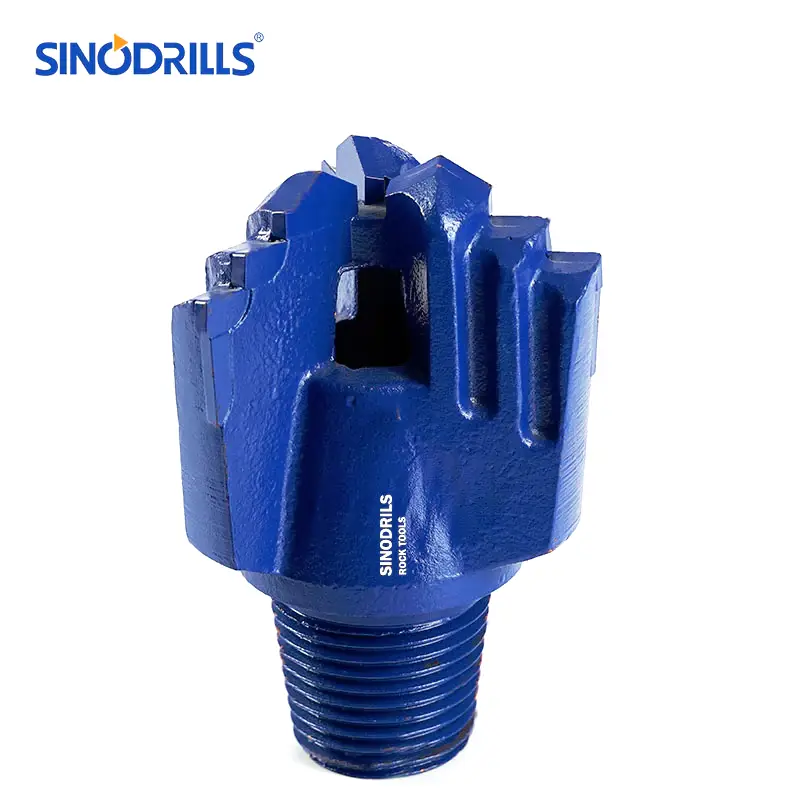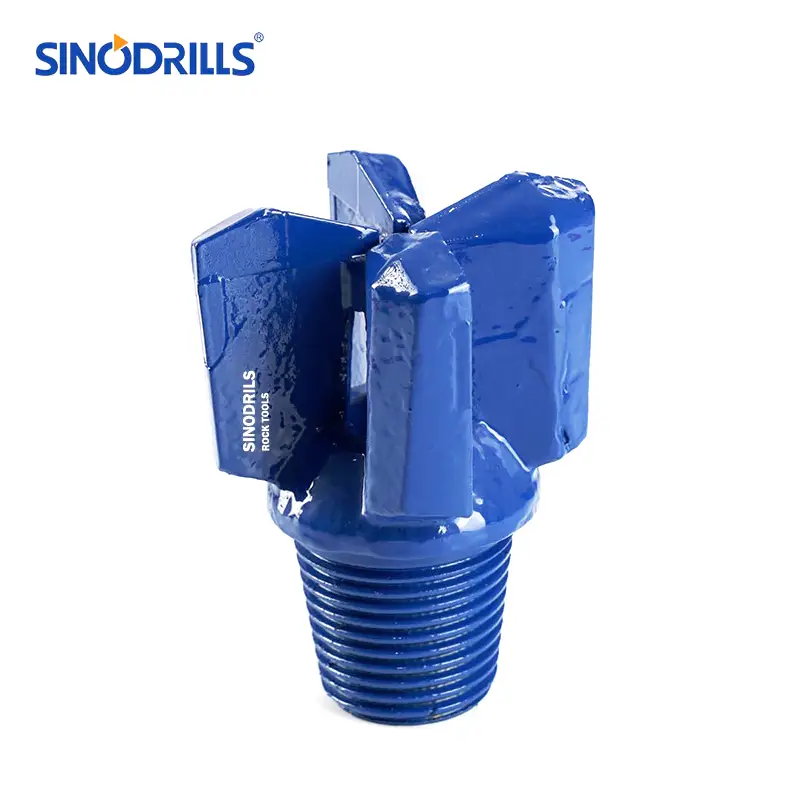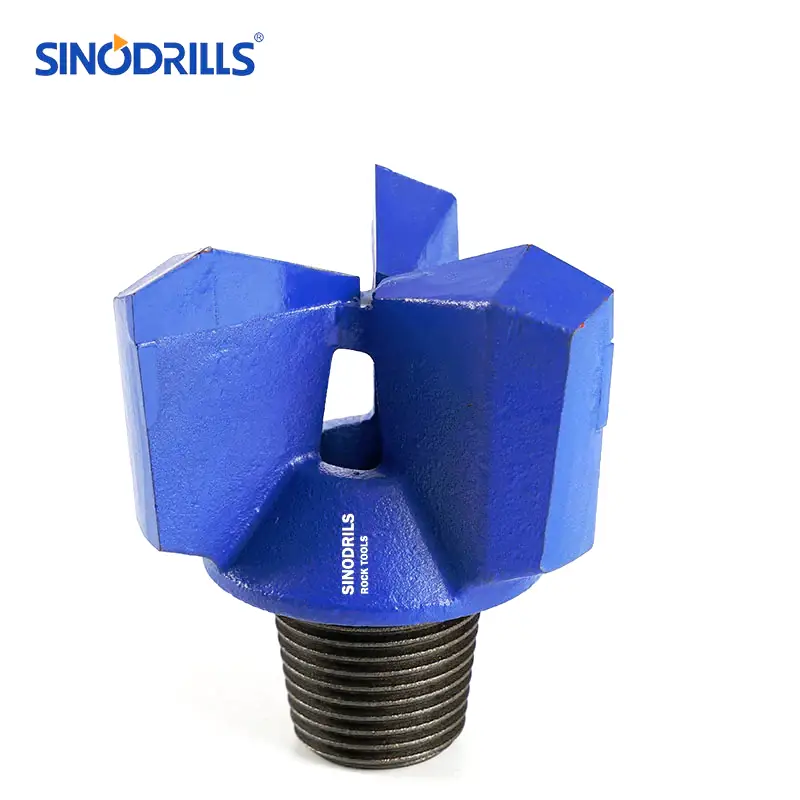Custom Drag Bits for Water Well Drilling Manufacturer in China
We provide drag bits specifically engineered for water well drilling. These bits are ideal for drilling through softer formations like clay, sand, and unconsolidated materials. Their robust wing design and efficient cutting action ensure fast penetration rates and effective spoil removal. Our drag bits offer consistent performance, making them a reliable choice for shallow to medium depth water well projects.
Sinodrills - Your Trusted Drag Bits for Water Well Drilling Manufacturer from China
Sinodrills is your trusted manufacturer from China for drag bits tailored for water well drilling. We specialize in producing durable and efficient drag bits designed to excel in softer ground conditions. Our commitment to reliable manufacturing ensures consistent performance, providing you with cost-effective tools for rapid penetration and effective spoil removal in various water well projects.
Various Drag Bits for Water Well Drilling
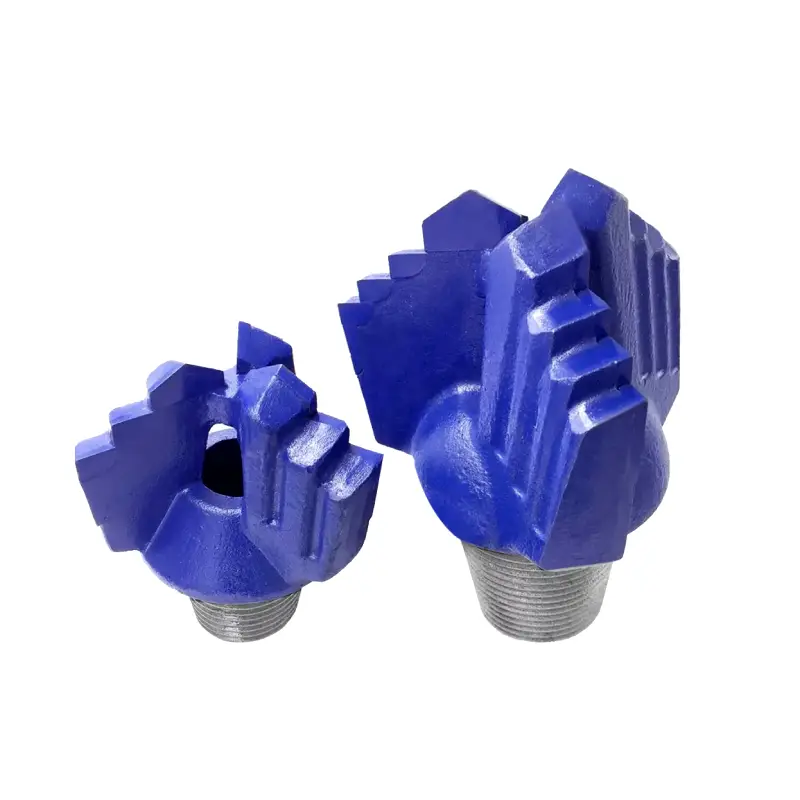
3 wing drag bits for water well drilling
We supply 3-wing drag bits for water well drilling, engineered for optimal performance in soft to medium-hard ground. Their three-wing design enhances stability and cutting efficiency, ensuring faster penetration and superior borehole cleaning. These bits are durable and reliable, making them an excellent choice for consistent results in various geological conditions encountered during water well installations.

three wing carbide step drag bit for well drilling
We supply three-wing carbide step drag bits, specifically engineered for efficient well drilling. These bits feature durable carbide inserts and a stepped design that enhances cutting action and improves penetration rates in softer to medium formations. Ideal for water well and shallow geothermal projects, our drag bits ensure reliable performance, effective spoil evacuation, and contribute to faster drilling times.
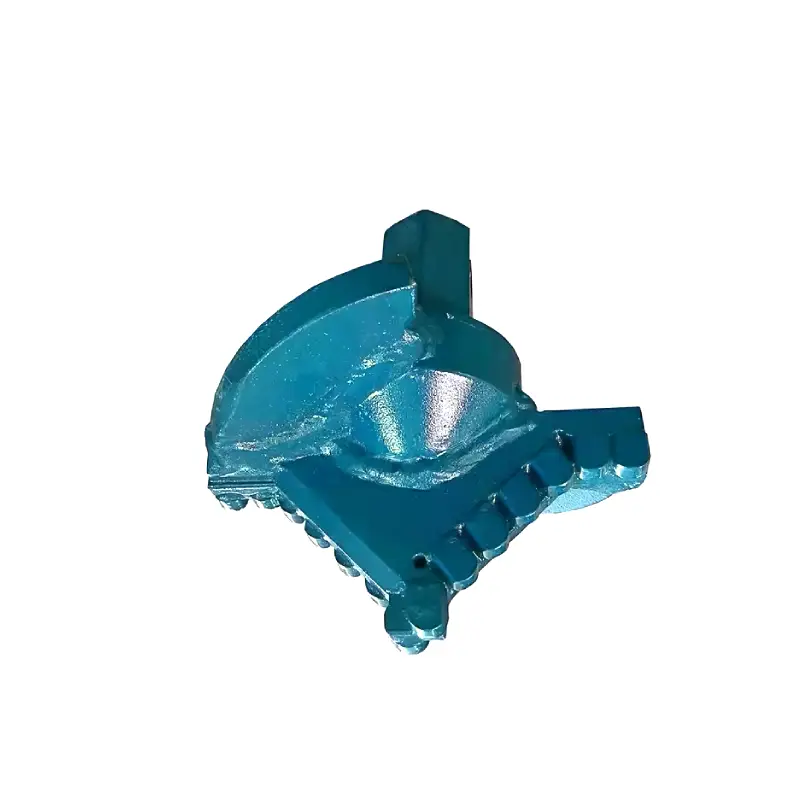
PDC auger drag bits for oil gas well drilling
We supply PDC auger drag bits specifically for well drilling. These advanced bits combine the aggressive cutting of PDC cutters with the efficient spoil removal of an auger design. Ideal for drilling through soft to medium-hard unconsolidated formations, they ensure faster penetration rates and prolonged bit life.
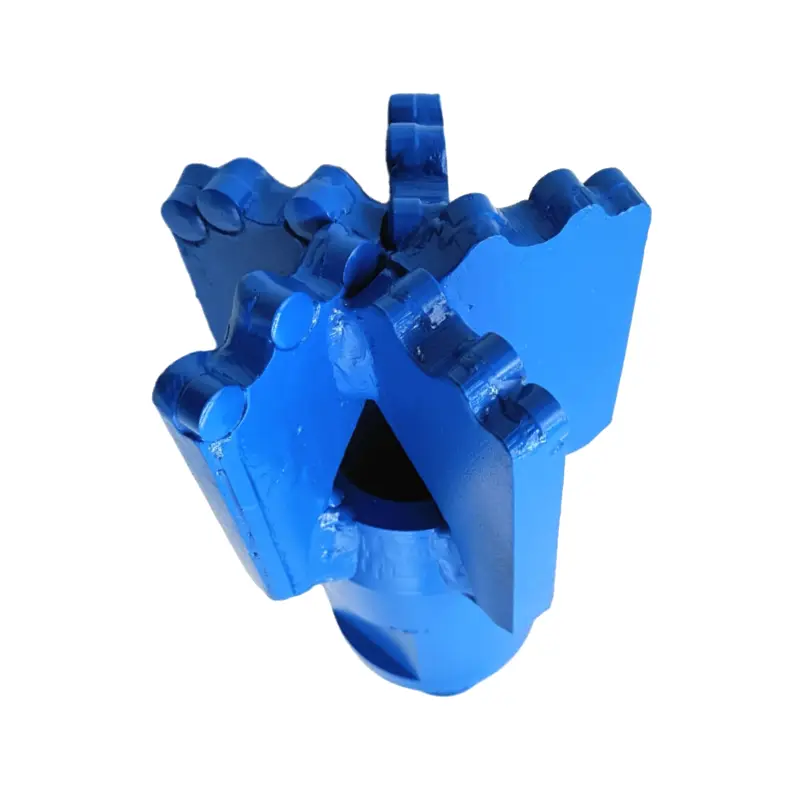
5 wing drag bits for water well drilling
We supply 3 wing drag bits specifically designed for water well drilling. These bits feature a robust three-wing design, optimizing cutting efficiency and spoil evacuation in soft to medium-hard formations such as sand, clay, and loose gravel. Our 3 wing drag bits offer fast penetration rates and extended bit life, making them a dependable choice for your water well drilling operations.
Customize Your Desired Drag Bits for Water Well Drilling
Bit Body Material
We offer customization of the drag bit body material to match the specific demands of your drilling environment. Options typically include high-grade alloy steels for superior toughness and wear resistance, or specialized heat-treated steels for enhanced durability in abrasive conditions. Selecting the right body material ensures the bit can withstand the rotational forces and impacts encountered, prolonging its lifespan and preventing premature failure during drilling.
Wing/Blade Configuration
We offer customization in the number and design of the cutting wings or blades. Common configurations include 2-wing, 3-wing, or 4-wing designs, each optimized for different formations. The angle, height, and sharpness of the blades can also be adjusted. This customization impacts penetration rates, cutting efficiency, and spoil evacuation. A tailored wing configuration ensures optimal performance in formations ranging from soft clays to unconsolidated sands and gravels.
Cutting Element Material and Type
We offer customization of the cutting elements, which are crucial for the bit’s cutting ability and wear resistance. Options include various grades of tungsten carbide inserts, or even PDC (Polycrystalline Diamond Compact) cutters for enhanced durability in tougher formations. The shape and placement of these elements are also customizable. Choosing the appropriate cutting material and type ensures effective rock fragmentation and extends the bit’s operational life in specific ground conditions.
Shank and Connection Type
We offer customization of the shank and connection type to ensure seamless compatibility with your drilling rig and drill rods. This includes various API (American Petroleum Institute) thread standards, such as API Reg or API IF, and specific pin or box connections. Customizing this aspect guarantees a secure fit, efficient power transfer from the rig to the bit, and prevents costly delays due to incompatible equipment, ensuring a smooth drilling operation.
what is drag bit for water well drilling?
A drag bit for water well drilling is a type of drill bit characterized by its fixed, non-rotating cutting wings or blades, typically made of hardened steel or tungsten carbide.
Designed primarily for drilling through softer, unconsolidated formations such as sand, clay, shale, and loose gravel, it cuts by scraping, shearing, or dragging the material away from the bottom of the borehole. Its simple, robust design allows for efficient penetration rates and effective removal of cuttings in these specific geological conditions, making it a cost-effective and common choice for shallow to medium-depth water well applications.
What is a drag bit in drilling?
A drag bit is a type of drill bit characterized by its fixed, non-rotating cutting edges or wings, typically made from hardened steel or tungsten carbide.
Unlike roller cone bits that crush or grind, a drag bit works by scraping, shearing, or “dragging” through the formation. It is primarily designed for drilling in softer, unconsolidated geological materials such as sand, clay, shale, and loose gravel.
Its robust and simple construction, without moving parts, allows for efficient penetration and effective removal of cuttings in these specific conditions, making it a cost-effective choice for many shallow to medium-depth drilling applications.
drag bit for welling drilling benefits
Drag bits offer several distinct advantages for water well drilling, particularly in suitable geological conditions. Their design and operational characteristics contribute to efficient and economical drilling.
- Cost-Effectiveness: Drag bits are generally less expensive to purchase and maintain compared to more complex drill bits like roller cones or PDC bits, making them a budget-friendly option for many water well projects.
- High Penetration Rates in Soft Formations: They excel in drilling through unconsolidated materials such as sand, clay, shale, and loose gravel, achieving rapid penetration rates due to their effective scraping and shearing action.
- Simplicity and Durability: With no moving parts, drag bits are inherently simpler in design, reducing the likelihood of mechanical failure downhole. This leads to increased durability and less downtime.
- Efficient Cuttings Removal: The design of the wings facilitates efficient removal of drill cuttings up the borehole, preventing re-grinding of material and maintaining a clean drilling environment.
- Easy Maintenance: Due to their straightforward construction, drag bits are relatively easy to repair or re-sharpen, allowing for prolonged use and further contributing to cost savings.
What drill bits to choose for water well drilling?
Choosing the right drill bit for water well drilling is critical for efficiency and cost-effectiveness, and the best choice depends heavily on the specific geological formations expected at the site. A thorough understanding of the subsurface soil and rock types will guide the selection to optimize penetration rates and bit longevity.
- Drag Bits: Ideal for drilling through soft, unconsolidated formations like sand, clay, shale, and loose gravel. They are cost-effective and achieve high penetration rates by scraping and shearing.
- Roller Cone Bits (Tricone Bits): Versatile for a wide range of formations from soft to very hard rock. They crush and chip the rock, making them suitable when encountering varied or harder layers.
- PDC (Polycrystalline Diamond Compact) Bits: Excellent for drilling through soft to medium-hard, non-abrasive formations such as shale, limestone, and sandstone. They offer very high penetration rates due to their shearing action.
- Hammer Bits (DTH – Down-The-Hole): Best for drilling in hard, abrasive rock formations where high percussive force is needed to fracture the rock efficiently. They offer superior penetration rates in competent rock.
- Core Bits: Used when intact rock samples are required for detailed geological analysis, though less common for general water well drilling unless specific formation data is needed.
What are the different types of drag bits?
Drag bits come in various configurations, each designed to optimize drilling performance in specific soft to medium-hard geological formations.
The primary differences lie in the number and design of their cutting wings or blades, which dictate their effectiveness in different soil types and their ability to clear cuttings.
- 2-Wing Drag Bits (Step-Type): These bits feature two cutting wings or blades. They are typically used for drilling softer formations like loose sand, clay, and soft shale, offering good penetration rates and efficient removal of cuttings. Their simplicity makes them cost-effective.
- 3-Wing Drag Bits: Equipped with three cutting wings, these bits offer increased stability and cutting efficiency compared to two-wing designs. They are well-suited for drilling through softer to medium-hard formations, including compacted sands, clays, and gravel, providing smoother drilling and improved hole cleaning.
- 4-Wing Drag Bits: With four wings, these bits provide even greater stability and cutting coverage. They are effective in a wider range of unconsolidated and semi-consolidated formations, including mixed soils with some loose gravel. The additional wings help in better centralization and more thorough cutting.
- Chevron Drag Bits: These bits feature wings with a “V” or chevron shape. This design is particularly effective in highly cohesive soils like sticky clays, as the chevron pattern helps to break up and evacuate the cuttings more efficiently, preventing balling up and improving penetration.
- Blade-Type Drag Bits (Straight Blade): Characterized by straight, broad blades, these are often used for drilling large-diameter holes in very soft, unconsolidated formations. They provide high rates of penetration and excellent hole cleaning in materials that are easily cut and evacuated.
- Stepped Drag Bits: Some drag bits incorporate a “stepped” design where cutting blades are set at different heights. This allows for more aggressive cutting action, breaking down the formation in stages, and can be beneficial in slightly harder or mixed unconsolidated formations.
What is the difference between PDC and TCI Drag bits?
PDC and TCI bits are two primary types of drill bits used in rotary drilling, each distinguished by their cutting elements and optimal performance in different rock formations. While both are designed for efficient rock penetration, their underlying technology and application niches vary significantly.
PDC Bits (Polycrystalline Diamond Compact)
PDC bits utilize cutters made of polycrystalline diamond compacts, which are synthetic diamonds bonded to a tungsten carbide substrate. These cutters are fixed directly onto the bit body. The primary cutting action of a PDC bit is through shearing or scraping the rock formation, meaning they slice through the rock rather than crushing it. This design allows them to operate with lower drilling pressure and higher rotational speeds, leading to very high rates of penetration.
Difference from TCI: The key difference lies in their cutting mechanism and material. PDC bits are characterized by their fixed, sharp diamond cutters that shear rock, excelling in softer to medium-hard, non-abrasive formations like shale, sandstone, and limestone. They are known for superior penetration rates and longevity in suitable formations, often providing a smoother drilling experience with less vibration.
TCI Bits (Tungsten Carbide Insert)
TCI bits, a type of roller cone (tricone) bit, employ tungsten carbide inserts pressed into the cones of the bit. These inserts are typically spherical, conical, or chisel-shaped. The cutting action of a TCI bit is primarily through crushing and chipping the rock formation as the cones roll on the bottom of the borehole. The type and arrangement of the tungsten carbide inserts are varied to suit different rock hardnesses and abrasiveness.
Difference from PDC: In contrast to PDC bits, TCI bits rely on a crushing and chipping action delivered by rotating cones. They are highly versatile and excel in a broader range of formations, particularly medium to very hard and abrasive rock types like granite, quartzite, and hard limestone, where PDC cutters might be prone to chipping or rapid wear. TCI bits are known for their robustness and ability to withstand high impact loads.
Send Your Inquiry Now
All-in-one Drag Bits for Water Well Drilling Solutions for Your Project
Sinodrills offers all-in-one drag bits for water well drilling, providing complete solutions for your projects. We customize bit body material, wing configuration, cutting elements, and connection types to perfectly match your geological conditions. Our expertise ensures optimal penetration, durability, and cost-effectiveness, delivering reliable performance from soft soils to semi-consolidated formations, streamlining your drilling operations.

